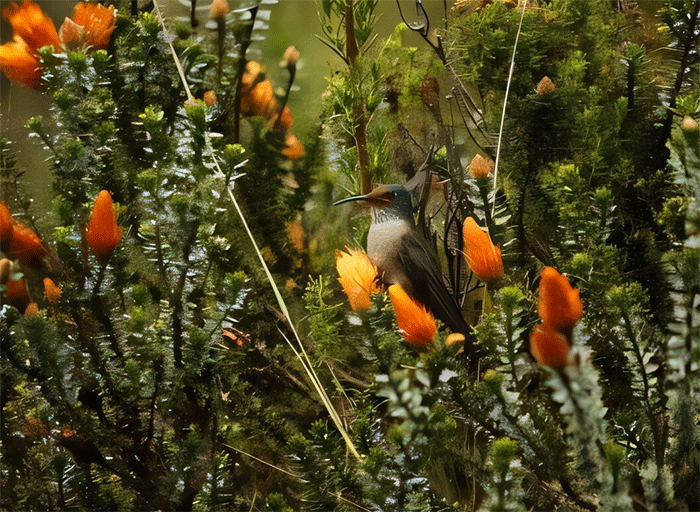Scientists Discover Unusual Colony Nesting in Andean Hummingbirds
by Bowling Green State University
Recent research by Bowling Green State University scientists has sent shockwaves through the bird-watching world after discovering atypical behaviour in hummingbirds.

Hummingbirds are often highly aggressive and territorial, but in the tough terrains of the Andes Mountains, BGSU researchers found a species of hummingbird is living cohesively with its peers.
At first sight, Gustavo Cañas-Valle, an ornithologist and BGSU alumnus, said he couldn't quite believe what he was observing: Chimborazo Hillstar hummingbirds in his native Ecuador were not fighting over nesting territories, but actively sharing them.
"It was mind-boggling," he said. "I knew hummingbirds were usually very aggressive to each other, so finding them nesting in the same location was amazing."
When he reported back to Dr. Juan Bouzat, an evolutionary biologist and professor at BGSU, Bouzat was skeptical.
"Hummingbirds are not a species like penguins where you see hundreds of them together," Bouzat said. "These are hummingbirds that live in the High Andes, above 10,000 feet, in a very, very harsh environment above the tree line."
As Cañas-Valle and Bouzat completed their research, which was published in the journal Ornithology, they sought a means of testing whether Chimborazo Hillstar hummingbirds were simply nesting together due to a lack of sites away from predators and the tough environmental conditions of the High Andes.
"The first intuition was to say there might not be enough space—the landscape doesn't offer them suitable locations to nest in safe, protected places," Bouzat said. "Thus, we surveyed the landscape for potential sites that would be appropriate for solitary nesting."
Cañas-Valle studied the area, a large national park in Ecuador, and found potential sites for solitary nesting: ravines with culverts, concrete structures that allow for drainage to pass under roads.
The sites in which solitary nesting was possible gave Cañas-Valle and Bouzat a semi-natural experiment ground in which to test their hypothesis about the role environment plays in the hummingbird's social groupings.
While some culverts had solitary nests, not all sites were used. More than 80% of active nests observed were present in colonies together with roosting individuals, likely the first ever documented example of colonial nesting and roosting by a species of hummingbird.
"Some culverts showed signs of past use but were not being recurrently used across years as it happens with most birds, which was very strange," Cañas-Valle said. "If our hypothesis that the hummingbirds are getting together because of reduced availability of nesting sites was correct, then every site available for solitary nesting should be used. But that didn't happen—many culverts were not used."
The finding further suggested that Chimborazo Hillstar ummingbirds likely evolved to be colonial for other reasons.
"In evolutionary biology, reproductive success is the currency for adaptive evolution. Colonies typically evolve over a long time and become socially cohesive, in some cases leading to complex cooperation among individuals," Bouzat said. "Somehow, they get a benefit—increasing their reproductive success—from being associated with the social group."
Preliminary observations suggest that Chimborazo Hillstar colonies may have evolved social adaptive traits. As Cañas-Valle watched the hummingbirds leave their colonies, he compared it to a sporting event in which players are introduced one at a time.
About 80% of the birds went in the same direction, he said.
"There is a theory of information exchange as one of the potential explanations for coloniality," he said. "This is only speculation right now, but hummingbirds may get easier access to mates and food resources by an exchange of information between members of a colony. Those are the two most important things the hummingbirds gain, with also gaining a safe place to sleep that is slightly away from the harsh winds of the Chimborazo volcano region."
Prior to the paper being accepted for publication, Cañas-Valle joked that Bouzat, his advisor at BGSU, was the toughest one to convince that the hummingbirds were living in a colony.
But after years of work, the pair compiled research that added a new understanding about the evolution of coloniality and hummingbirds.
"It took me probably two years for Juan to say, 'Well, Gustavo, you convinced me. We can call this gathering of nests a colony from now on,'" he said. "I was thinking, 'Finally.' That was a priceless moment."
14 Mar 2025
Share this story







